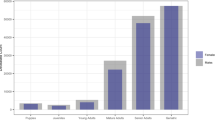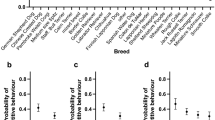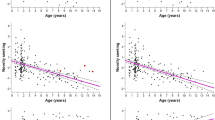Abstract
The Dog Aging Project is a long-term longitudinal study of ageing in tens of thousands of companion dogs. The domestic dog is among the most variable mammal species in terms of morphology, behaviour, risk of age-related disease and life expectancy. Given that dogs share the human environment and have a sophisticated healthcare system but are much shorter-lived than people, they offer a unique opportunity to identify the genetic, environmental and lifestyle factors associated with healthy lifespan. To take advantage of this opportunity, the Dog Aging Project will collect extensive survey data, environmental information, electronic veterinary medical records, genome-wide sequence information, clinicopathology and molecular phenotypes derived from blood cells, plasma and faecal samples. Here, we describe the specific goals and design of the Dog Aging Project and discuss the potential for this open-data, community science study to greatly enhance understanding of ageing in a genetically variable, socially relevant species living in a complex environment.
This is a preview of subscription content, access via your institution
Access options
Access Nature and 54 other Nature Portfolio journals
Get Nature+, our best-value online-access subscription
$32.99 / 30 days
cancel any time
Subscribe to this journal
Receive 51 print issues and online access
$199.00 per year
only $3.90 per issue
Buy this article
- Purchase on SpringerLink
- Instant access to full article PDF
Prices may be subject to local taxes which are calculated during checkout



Similar content being viewed by others
Data availability
The data used to generate Fig. 1b, c are freely available for download at https://data.dogagingproject.org.
Change history
08 August 2022
A Correction to this paper has been published: https://doi.org/10.1038/s41586-022-05179-x
References
Kaeberlein, M., Rabinovitch, P. S. & Martin, G. M. Healthy aging: the ultimate preventative medicine. Science 350, 1191–1193 (2015). This paper makes a compelling argument that treatments that target the underlying causes of ageing could ameliorate the effects of multiple age-related diseases.
Melzer, D., Hurst, A. J. & Frayling, T. Genetic variation and human aging: progress and prospects. J. Gerontol. A Biol. Sci. Med. Sci. 62, 301–307 (2007).
Manolio, T. A. et al. Finding the missing heritability of complex diseases. Nature 461, 747–753 (2009).
Kaeberlein, M., Creevy, K. E. & Promislow, D. E. L. The Dog Aging Project: translational geroscience in companion animals. Mamm. Genome 27, 279–288 (2016).
Boyko, A. R. et al. A simple genetic architecture underlies morphological variation in dogs. PLoS Biol. 8, e1000451 (2010). This paper demonstrated the tremendous power of the domestic dog as a model for mapping natural variation for complex traits.
Minnema, L. et al. Correlation of artemin and GFRα3 with osteoarthritis pain: early evidence from naturally occurring osteoarthritis-associated chronic pain in dogs. Front. Neurosci. 14, 77 (2020).
Harris, P. A. et al. Research Electronic Data Capture (REDCap)—a metadata-driven methodology and workflow process for providing translational research informatics support. J. Biomed. Inform. 42, 377–381 (2009).
Harris, P. A. et al. The REDCap consortium: building an international community of software platform partners. J. Biomed. Inform. 95, 103208 (2019).
Li, J. H., Mazur, C. A., Berisa, T. & Pickrell, J. K. Low-pass sequencing increases the power of GWAS and decreases measurement error of polygenic risk scores compared to genotyping arrays. Genome Res. 31, 529–537 (2021).
Franceschi, C. & Campisi, J. Chronic inflammation (inflammaging) and its potential contribution to age-associated diseases. J. Gerontol. A Biol. Sci. Med. Sci. 69, S4–S9 (2014).
Lippi, G. et al. Preanalytical challenges—time for solutions. Clin. Chem. Lab. Med. 57, 974–981 (2019).
Haumann, R. & Verspaget, H. W. Quality-assured biobanking: the Leiden University Medical Center model. Methods Mol. Biol. 1730, 361–370 (2018).
Simeon-Dubach, D., Zeisberger, S. M. & Hoerstrup, S. P. Quality assurance in biobanking for pre-clinical research. Transfus Med. Hemother. 43, 353–357 (2016).
US Department of the Census. American Community Survey (ACS): Public Use Microdata Sample (PUMS), 2009. https://doi.org/10.3886/ICPSR33802.v1 (Inter-university Consortium for Political and Social Research, 2013).
Kim, S.-Y. et al. Concentrations of criteria pollutants in the contiguous U.S., 1979–2015: role of prediction model parsimony in integrated empirical geographic regression. PLoS ONE 15 e0228535 (2020).
Vose, R. S. et al. NOAA Monthly U.S. Climate Divisional Database (NClimDiv). https://doi.org/10.7289/V5M32STR (NOAA National Climatic Data Center, 2014).
Mooney, S. J. et al. Residential neighborhood features associated with objectively measured walking near home: revisiting walkability using the Automatic Context Measurement Tool (ACMT). Health Place 63, 102332 (2020).
Wilfond, B. S., Porter, K. M., Creevy, K. E., Kaeberlein, M. & Promislow, D. Research to promote longevity and health span in companion dogs: a pediatric perspective. Am. J. Bioeth. 18 64–65 (2018).
Taylor, H. A., Morales, C., Johnson, L.-M. & Wilfond, B. S. A randomized trial of rapamycin to increase longevity and healthspan in companion animals: navigating the boundary between protections for animal research and human subjects research. Am. J. Bioeth. 18, 58–59 (2018).
Bisong, E. in Building Machine Learning and Deep Learning Models on Google Cloud Platform: A Comprehensive Guide for Beginners (ed. Bisong, E.) 7–10 (Apress, 2019).
Salvin, H. E., McGreevy, P. D., Sachdev, P. S. & Valenzuela, M. J. The canine cognitive dysfunction rating scale (CCDR): a data-driven and ecologically relevant assessment tool. Vet. J. 188, 331–336 (2011).
Acknowledgements
All dog research described here, including informed owner consent, is approved by the Texas A&M University Institutional Animal Care and Use Committee, under AUPs 2018-0401 CAM and 2018-0368 CAM. The DAP is supported by grant U19AG057377 from the National Institute on Aging, a part of the National Institutes of Health, and by private donations. We thank S. Moon for help in preparing figures.
Author information
Authors and Affiliations
Consortia
Contributions
K.E.C., M.K. and D.E.L.P. conceived of the DAP; J.M.A., K.E.C., M.K. and D.E.L.P. wrote the initial draft of this paper. All authors, including consortium authors, have been involved in the design and implementation of DAP goals, infrastructure and activities, and they have had the opportunity to participate in editing both form and content of this paper and have approved the final version.
Corresponding author
Ethics declarations
Competing interests
The authors declare no competing interests.
Peer review information
Nature thanks Steven Austad, Dario Valenzano and Eric Verdin for their contribution to the peer review of this work.
Additional information
Publisher’s note Springer Nature remains neutral with regard to jurisdictional claims in published maps and institutional affiliations.
Rights and permissions
Springer Nature or its licensor holds exclusive rights to this article under a publishing agreement with the author(s) or other rightsholder(s); author self-archiving of the accepted manuscript version of this article is solely governed by the terms of such publishing agreement and applicable law.
About this article
Cite this article
Creevy, K.E., Akey, J.M., Kaeberlein, M. et al. An open science study of ageing in companion dogs. Nature 602, 51–57 (2022). https://doi.org/10.1038/s41586-021-04282-9
Received:
Accepted:
Published:
Issue date:
DOI: https://doi.org/10.1038/s41586-021-04282-9
This article is cited by
-
Applying a life course approach to elucidate the biology of sex differences in frailty: early-life gonadectomy diminishes late-life robustness in male and female dogs in the Exceptional Aging in Rottweilers Study
Biology of Sex Differences (2025)
-
Multi-omics analysis of canine aging markers and evaluation of stem cell intervention
Communications Biology (2025)
-
Functional assessments of short-term spatial memory in the Dog Aging Project identify strong associations with age that are not moderated by body mass
GeroScience (2025)
-
Comparing owner reported and genetic breed identification reveals high concordance in a large cohort from the Dog Aging Project
Scientific Reports (2025)
-
Test of Rapamycin in Aging Dogs (TRIAD): study design and rationale for a prospective, parallel-group, double-masked, randomized, placebo-controlled, multicenter trial of rapamycin in healthy middle-aged dogs from the Dog Aging Project
GeroScience (2025)




David Gardner
Authors,
A great project and resource. Cannot agree more with the objectives and 'one-health' approach - using real animal models of disease to look at the real-world G x E interactions. I note one omission: i couldnt see anywhere reference to consideration of nutrition as a determinant of 'health'. All canine participants fed 'complete' diet (despite many not being entirely complete), wet or dry kibble? are you recording these sort of factors that could add significant variability to your dataset.